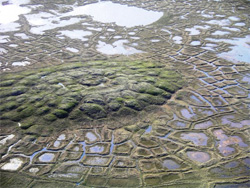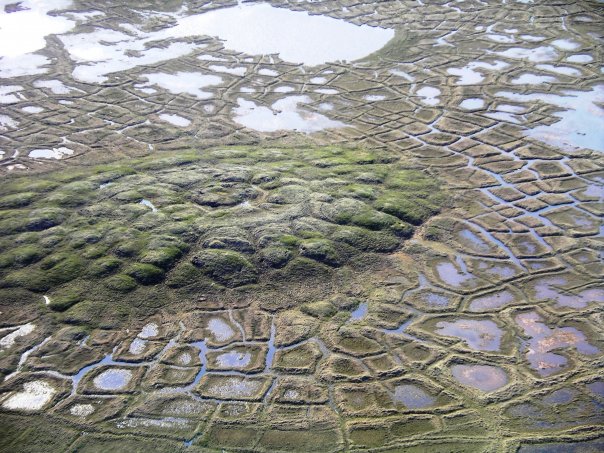The Menace of Underground Ice
Freezing water underground causes billions of dollars of damage to roads every year. In the October Physical Review E, researchers propose a new model for the process by which small ice crystals can grow into the large sheets that cause the ground to swell. The theory could help researchers predict the types of soil and weather conditions that lead to this destructive process.
“Frost heaves” from freezing ground water can generate humps that raise large sections of roadway and can splay trees into “drunken forests” of trunks tilting in random directions. Although it seems natural to blame the expansion of ice as it freezes, experiments with a liquid that shrinks on freezing show the same effect. The expansion actually occurs because horizontal sheets of underground ice known as “ice lenses” grow by sucking additional water up through the soil from a warmer liquid reservoir below.
Water embedded in soil is strongly influenced by its confinement into small pores and by its interaction with the soil particles. So it behaves very differently than ordinary water–it freezes at a different temperature, for example. Current theories for frost heave include these effects, but they require conditions that aren’t always found in the real world and have trouble explaining certain observations. With their new theory, Stephen Peppin of Oxford University in England and his colleagues derive all of the main observations from a few basic physics principles. Rather than starting with a uniformly porous soil, their theory assumes that the lens grows from an ice-filled pore or “flaw” in the soil that is extra-large (perhaps ten times as large as the soil particles).
The team’s model assumes that the temperature is well below freezing at the ground surface but rises deeper into the earth. The goal is to predict the conditions and depths at which buried ice grows. To understand the relationship between ice particles and the surrounding moist soil, think of ordinary water drops surrounded by water vapor. As the air cools on a summer night, it can hold less vapor. When the temperature hits the dew point, condensation occurs, which causes any drops of liquid on the grass to grow. Peppin and his colleagues derived the equivalent of the dew point for ice lenses, the temperature Tl below which the ice phase is favored to grow as it draws in liquid from the soil. This formation temperature is always below freezing, although it increases deeper in the soil where there is more water.
But the lens can’t grow unless it can force a crack sideways through the soil, which requires the ice to generate sufficient pressure. Reaching this pressure threshold in turn demands that the temperature be somewhat below Tl. The team calls it “geometrical supercooling” when an ice particle is colder than Tl but can’t grow because of the soil’s cohesion. Only where the temperature is far enough below Tl can the ice generate enough pressure to push through the soil. The researchers calculate the depth at which the temperature is farthest below Tl and predict that lenses will grow there. Once an extended lens forms, it sucks away the nearby ground water, and the optimum growth point moves lower, which leads to the “ladder” of parallel ice sheets observed in the field.
The team finds that the temperature only dips below Tl if the amount of water that the soil can hold–the permeability–increases as you go down from an existing lens. This result explains why a “frozen fringe” of ice in the porous soil is often, but not always, seen below real ice lenses. This frozen soil limits the flow of water and reduces the permeability, but there are other conditions that can accomplish the same thing. The team says their theory agrees reasonably well with measurements of the cooling needed to create ice lenses in the lab, but more experiments are needed.
The idea that ice lenses start as large flaws relative to the soil pores is “quite new,” says Alan Rempel, of the University of Oregon in Eugene. He adds that “it does bring about some interesting possibilities” for comparison with experiments, because the theory predicts quantitatively how the phenomenon should depend on the conditions and soil properties.
–Don Monroe
Don Monroe is a freelance science writer in Murray Hill, New Jersey.





